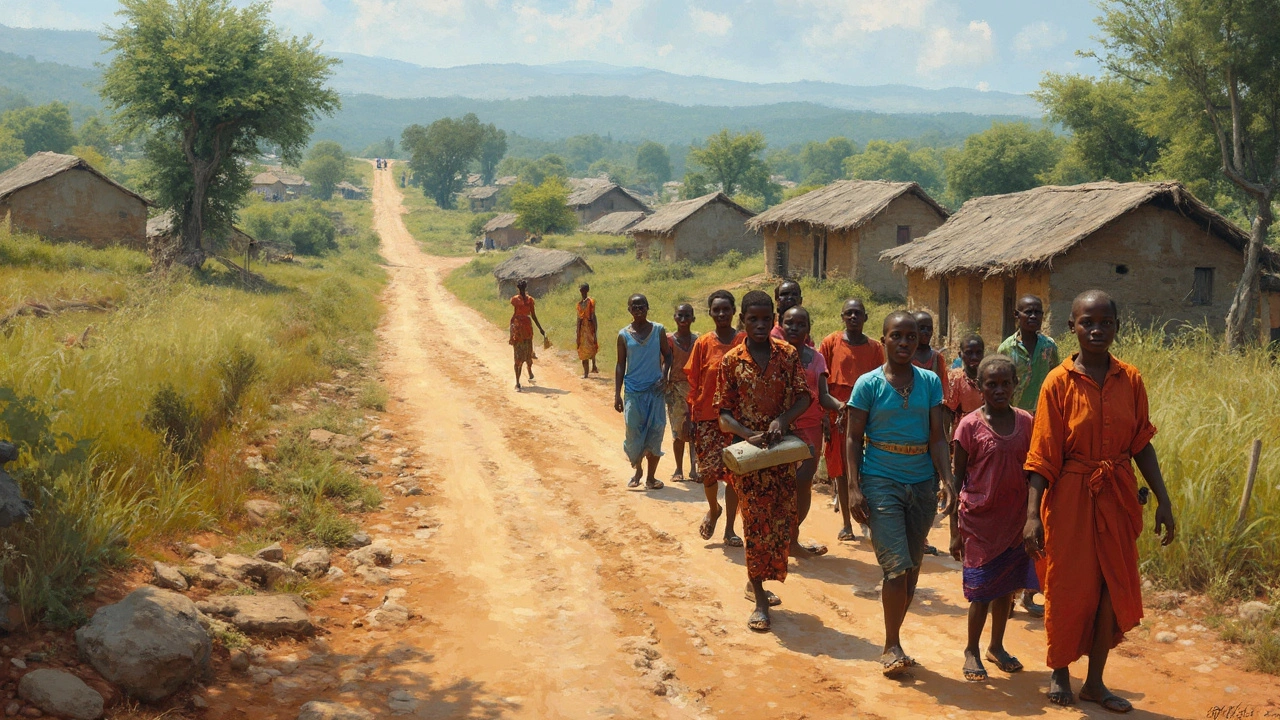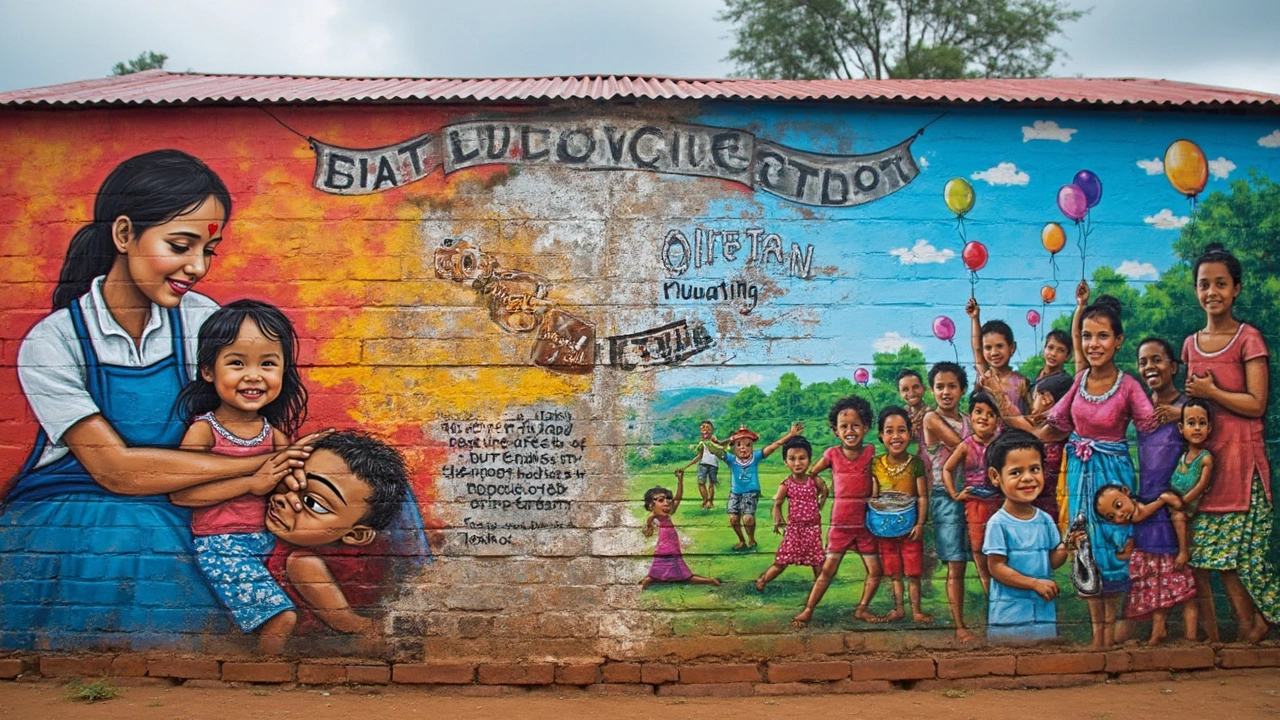Imagine a world where a simple scratch is not just a minor nuisance, but a potentially life-threatening event. That's the unfortunate reality for many people living in developing countries, where tetanus still poses a significant health risk. Tetanus, a disease caused by bacteria commonly found in soil, dust, and animal feces, can lead to severe muscle spasms and even death if not treated promptly. Yet in some parts of the world, getting timely healthcare is easier said than done.
In these regions, access to healthcare facilities and vaccinations isn't guaranteed. It’s not always about the absence of modern medicine or lack of knowledge among medical professionals—sometimes, it’s simply about geography and infrastructure. People living in remote areas face logistical hurdles that make receiving and administering vaccines a lot more complicated than it should be.
What's being done to bridge this gap? Some organizations and governments are stepping up their game by setting up mobile clinics to bring vaccines directly to those in need. This kind of proactive approach, combined with community education, has shown promise. Educating communities about the importance of tetanus vaccinations could be a game-changer, as public awareness often stands as the first line of defense against disease outbreaks.
- Current Situation of Tetanus
- Barriers to Controlling Tetanus
- Impact on Communities
- Innovative Solutions
- Future Prospects
Current Situation of Tetanus
Though largely preventable, tetanus continues to be a serious threat in many developing countries. Poor vaccination coverage and limited healthcare access have resulted in ongoing challenges. The disease primarily affects unvaccinated individuals, often in rural areas where healthcare infrastructure is lacking.
Each year, tetanus claims tens of thousands of lives, with neonates and mothers during childbirth facing the highest risk. The World Health Organization reports that neonatal tetanus is a leading cause of infant mortality in less developed regions. Controlling this disease is crucial as tetanus is a formidable enemy with a case fatality rate varying from 10% to even 40% in some instances.
Vaccination Challenges
Vaccination efforts are hampered by a variety of factors. First, logistical issues make it tough to transport and store vaccines properly, especially in remote or unstable areas where cold chain facilities may not be available. Moreover, misinformation and mistrust toward vaccines persist, sometimes leading to resistance or refusal.
Healthcare Infrastructure
Many healthcare systems in developing nations are not adequately equipped to manage outbreaks. With limited staff and supplies, hospitals and clinics struggle to provide the necessary care. As a result, early diagnosis and timely intervention are rare, exacerbating the problem.
Statistics on Tetanus
| Region | Reported Tetanus Cases (2023) |
|---|---|
| Sub-Saharan Africa | 14,000 |
| South Asia | 12,000 |
| Latin America | 3,500 |
Efforts are being made to address these issues through international collaborations. However, sustainable progress depends on both financial investment and local community involvement. Understanding these foundational challenges is crucial in moving toward effective solutions.
Barriers to Controlling Tetanus
Tackling tetanus in developing countries is more complex than just rolling out vaccines. There are several hurdles that make controlling the disease quite challenging.
Poor Healthcare Infrastructure
One of the most significant issues is the inadequate healthcare infrastructure. Many rural areas lack hospitals or clinics within easy reach. With roads often in poor condition, getting to a facility could mean traveling hours, which isn’t practical for routine vaccinations or emergencies.
Limited Access to Vaccinations
Even when facilities are available, they might lack a steady supply of vaccines. Interruptions in vaccine supply chains, due to logistical challenges or funding cuts, can lead to stock shortages. Without a continuous supply, maintaining vaccination schedules becomes a huge challenge.
Public Awareness and Education
A lack of public awareness about the importance of tetanus vaccines also plays a part. In some communities, misinformation or cultural beliefs might lead to skepticism towards vaccines. Educating people about the disease, how it spreads, and why vaccination is crucial can make a significant difference.
| Country | Vaccination Coverage |
|---|---|
| Mali | 72% |
| Nigeria | 68% |
| Ethiopia | 74% |
| India | 85% |
These numbers highlight the work that still needs to be done to reach wider coverage. While some progress has been made, there's much more ground to cover in tackling these issues head-on.
Economic Constraints
Many developing regions simply don't have the budget to prioritize healthcare infrastructure and vaccination programs. When funds are limited, critical projects like these often take a back seat. International aid and non-profit organizations sometimes fill the gap, but sustainable funding solutions are still needed.
Addressing these barriers requires a concerted effort from governments, international agencies, and local communities. It’s not just about providing vaccines, but ensuring they can be accessed and accepted by everyone who needs them.

Impact on Communities
The impact of tetanus on communities in developing countries is significant and far-reaching. To start with, it's crucial to understand that tetanus disproportionately affects the most vulnerable groups, such as newborns and mothers. This leaves families devastated and affects entire communities.
In rural settings, a large percentage of births still take place at home without access to sterile equipment, leading to neonatal tetanus. This is especially problematic in regions where access to clinics is limited. As a result, the death of a child doesn't just bring emotional distress but also economic strain on families already living on the edge.
Ripple Effects
Beyond the immediate health implications, tetanus has a ripple effect throughout communities. When a family member gets sick, it's not just a medical issue. It impacts the entire household's financial stability. Often, families have to prioritize treatment costs over daily necessities, which can even lead to increased poverty.
This disease doesn't just affect individuals; it stunts the growth of entire communities by diverting resources away from developing essential infrastructure and educational programs. Imagine a community that seemingly can't catch a break because it keeps allocating what little it has to healthcare instead of building a better future.
Statistics That Speak Volumes
Numbers make it painfully clear. According to a world health report, neonatal tetanus alone results in about 30,000 deaths each year. Many of these deaths are preventable through simple measures like vaccination and hygiene practices at childbirth. Below is a table that provides insights into the prevalence of tetanus in different regions:
| Region | Estimated Annual Tetanus Cases |
|---|---|
| Sub-Saharan Africa | 18,000 |
| South Asia | 9,000 |
| Southeast Asia | 3,000 |
While these numbers are staggering, they emphasize why addressing tetanus is crucial for improving quality of life in vulnerable areas. Long-term solutions should prioritize not just healthcare access but also public education to truly tackle this issue.
Innovative Solutions
Tackling tetanus in developing countries means thinking outside the box. Traditional solutions might fall short, so innovators are creating new paths forward. One such solution involves using mobile vaccination clinics. These roving healthcare units bring essential vaccines directly to remote communities. They operate out of vans or trucks equipped with refrigeration to keep vaccines effective during travel.
Community Training
Training local healthcare workers in tetanus prevention and treatment is pivotal. When locals, rather than outsiders, provide education, it resonates more with community members. Trained workers can organize small vaccination drives, educate parents about the risks of tetanus, and simplify myths versus facts. A picture is worth a thousand words, and sometimes a practical demo can make all the difference.
Leveraging Technology
Technology isn't just about the latest smartphone. In healthcare, mobile apps are being developed to track vaccine availability and coordinate vaccination schedules. Imagine a simple app alerting you about when the vaccine clinic is swinging by your area next. Quick and efficient notifications like these optimize coverage and reduce missed opportunities for vaccinations.
Building Partnerships
Governments alone can't handle the entire burden—enter partnerships. Strong collaborations between NGOs, healthcare providers, and local governments amplify efforts to battle tetanus. By pooling resources and knowledge, these groups ensure initiatives are sustainable long-term, not just flash-in-the-pan solutions.
Inclusive Healthcare Policies
Policies play a huge role too. Governments can implement national vaccination programs focusing on rural areas or provide subsidies making vaccines feasible for low-income families. Also, involving local leaders and influencers only escalates the outreach potential, turning a small spark into a community-wide flame of awareness and action.
This multifaceted approach, employing technology, partnerships, and mobile clinics, represents a tailored solution to meeting the healthcare challenges posed by tetanus. While some avenues need more investment or initial groundwork, the end result is poised to make a lasting impact. By broadening access and employing education effectively, we can outsmart tetanus, one dose at a time.

Future Prospects
Looking ahead, there are several exciting possibilities to tackle the issue of tetanus in developing countries. As the world becomes more interconnected, access to innovative healthcare solutions is improving. But what exactly could the future hold?
Leveraging Technology
Technology might just be the game-changer here. With smartphones becoming widespread, even in remote areas, there's potential for health apps that send reminders for vaccinations or educate users on tetanus prevention. Imagine an app that alerts health workers in nearby areas about who’s due for a tetanus shot. This is not science fiction; it's a plausible step forward.
Local Manufacturing
Producing vaccines locally in developing countries can greatly reduce costs and logistical hurdles. You skip the overseas shipping part, making vaccines more affordable and accessible. Some countries are already exploring this, and with the right support, it could reshape the health landscape entirely.
Community Involvement and Education
Empowering communities to take charge of their health could be a long-lasting solution. Educating people about the importance of tetanus vaccinations, and how to identify symptoms early, could dramatically cut down on infection rates. Community health workers play a crucial role in spreading this information.
In a nutshell, beating tetanus in these regions won't happen overnight, but the future is full of potential. With the right mix of technology, local initiatives, and community involvement, there's hope that we can turn the tide on this stubborn health challenge.


McKenna Baldock
When a community embraces the simple act of vaccinating its newborns, it not only shields individual lives but also weaves a fabric of collective security that endures beyond a single generation. In reflecting on this, I find that the most profound changes often begin with quiet, shared commitments rather than grand gestures.
March 11, 2025 AT 05:48
Roger Wing
Sure but you forget that most of these “mobile clinics” are funded by agencies that have hidden agendas and the vaccines themselves are often a cover for population control experiments
March 20, 2025 AT 20:46
Matt Cress
Oh great, another “innovative solution” that probably csts more than the GDP of the villge it’s supposed to help-who thought a truck full of cold boxes was a cultural breakthrough?
March 31, 2025 AT 07:46
Andy Williams
Actually, the phrase should read “costs more than the GDP of the village,” and while logistical challenges are real, many low‑resource settings have successfully deployed solar‑powered refrigeration without excessive expense.
April 10, 2025 AT 17:46
Paige Crippen
Many of the statistics quoted ignore the fact that a significant portion of the data is filtered through agencies that may manipulate numbers to secure continued funding for their own operations.
April 21, 2025 AT 03:46
sweta siddu
That’s a good point! 😊 It would be great to see more transparent data sharing so we can all understand the real impact and maybe suggest better ways to support those communities. 🌍
May 1, 2025 AT 13:46
Ted Mann
The battle against tetanus is, at its core, a reflection of humanity’s willingness to protect its most vulnerable members.
When we look beyond the cold statistics, we see mothers holding newborns in dimly lit homes, yearning for a simple protection that should be universal.
Technology, such as mobile health apps, can act as a silent guardian, reminding health workers of upcoming vaccination windows.
Yet the true power lies in the stories we share around village fires, where elders pass down knowledge that modern medicine can amplify.
If we invest in training locals to become vaccine ambassadors, the health system becomes less of an external imposition and more of a communal ally.
The paradox is that while we fear the unknown, we sometimes overlook the simple truth that a sterile needle and a clean birth kit can save lives.
Funding models must shift from short‑term grants to sustainable partnerships that respect local economies.
Imagine a future where a small solar fridge powers a continuous supply of tetanus toxoid in every remote clinic.
That vision is not fanciful; pilot projects in parts of Africa already demonstrate its feasibility.
Moreover, transparency in data collection will dispel myths and build trust, countering the very conspiracy narratives that feed fear.
Communities that feel heard are more likely to embrace vaccination, turning skepticism into collective action.
As we map these interventions, let us remember that every data point represents a human story waiting for a hopeful ending.
The moral imperative, therefore, is not only to deliver the shot but also to nurture the ecosystems that sustain health.
In this dance between science and society, humility and curiosity are our best partners.
So let us march forward, hand in hand, with open hearts and smart tools, confident that the sting of tetanus will one day be a distant memory.
May 11, 2025 AT 23:46